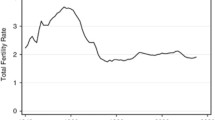Abstract
The long-term fall in household size in the United States is discussed within the framework of the aging of the population, continuing as the effects of fertility and mortality decline accumulate. Using distributions of households by size from U.S. census data 1790–1970 and a components of change analysis on primary individuals for 1950–1974, household changes are related to demographic change for the periods 1790–1900, 1900–1950, and 1950–1974. Fertility and mortality declines have unambiguous impact on household size until the increases in primary individuals begin. But these, too, have a theoretically interesting, if indirect relationship to population structure.
Similar content being viewed by others
References
Anderson, Michael S. 1971. Family Structure in Nineteenth Century Lancashire. London: Cambridge University Press.
Beresford, J. C., and A. M. Rivlin. 1966. Privacy, Poverty, and Old Age. Demography 3:247–258.
Berkner, L. 1973. Recent Research on the History of the Family in Western Europe. Journal of Marriage and the Family 35:395–405.
—. 1975. The Use and Misuse of Census Data for the Historical Analysis of Family Structure. Journal of Interdisciplinary History 5:721–738.
Coale, Ansley J., and Melvin Zelnick. 1963. New Estimates of Fertility and Population in the United States: A Study of Annual White Births from 1855 to 1960 and of Compietedness of Enumeration in the Censuses from 1880 to 1960. Princeton: Princeton University Press.
Durand, John, and K. C. Holden. 1969. Methods for Analyzing Components of Change in Size and Structure of the Labor Force with Application to Puerto Rico, 1950–60. University of Pennsylvania, Population Studies Center, Analytical and Technical Reports, No.8. Philadelphia.
Glick, P. C., and R. Parke, Jr. 1965. New Approaches in Studying the Life Cycle of the Family. Demography 2: 187–202.
Goodman, L. A., N. Keyfitz, and T. W. Pullum. 1974. Family Formation and the Frequency of Various Kinship Relationships. Theoretical Population Biology 5: 1–27.
Katz, Michael. 1972. Growing-up in the Nineteenth Century. Working Paper No. 31. Canadian Social History Project.
Kobrin, Frances E. 1971. Components of Change in United States Household Headship: A Cohort Analysis, 1940-1960. Unpublished Ph.D. dissertation. Philadelphia: Graduate School of Arts and Sciences, University of Pennsylvania.
—. 1973. Household Headship and Its Changes in the United States, 1940–1960, 1970. Journal of the American Statistical Association 68:793–800.
Laslett, B. 1973. The Family as a Public and Private Institution: An Historical Perspective. Journal of Marriage and the Family 35:480–492.
Laslett, P. 1970. The Decline of the Size of the Domestic Group in England: A Comment on J. W. Nixon’s Note. Population Studies 24: 449–454.
Levy, M., Jr. 1965. Aspects of the Analysis of Family Structure. Pp. 1–63 in Ansley J. Coale et aI., Aspects of the Analysis of Family Structure. Princeton: Princeton University Press.
Lyness, J. L., M. E. Lipetz, and K. E. Davis. 1972. Living Together: An Alternative to Marriage. Journal of Marriage and the Family 34:305–311.
Macklin, E. D. 1972. Heterosexual Cohabitation Among Unmarried College Students. The Family Coordinator 21:463–472.
Modell, J., and T. K. Hareven. 1973. Urbanization and the Malleable Household: An Examination of Boarding and Lodging in American Families. Journal of Marriage and the Family 35:467–479.
Norton, A. J. 1974. The Family Life Cycle Updated: Components and Uses. Pp. 162–169 in Robert F. Winch and Graham B. Sparrier (eds.), Selected Studies in Marriage and the Family, 4th edition. New York: Holt, Rinehart and Winston.
Pryor, E. T., Jr. 1972. Rhode Island Family Structure: 1875 and 1960. Pp. 571–589 in P. Laslett and R. Wall (eds.), Household and Family in Past Time. Cambridge, England: Cambridge University Press.
Ryder, N. B. 1974. Reproductive Behavior and the Family Life Cycle. Symposium on Population and the Family, Honolulu, August 6–15, 1973. New York: United Nations Economic and Social Council, World Population Conference.
Taeuber, Conrad, and Irene Taeuber. 1971. People of the United States in the 20th Century. A Census Monograph. Washington, D.C.: U’S, Government Printing Office.
United Nations. 1973a. Determinants and Consequences of Population Trends. New York: United Nations.
—. 1973b. Manual VII: Methods of Projecting Households and Families. New York: United Nations.
U.S. Bureau of the Census. 1909. A Century of Population Growth, 1790–1900. Washington, D.C.: U.S. Government Printing Office.
—. 1943. Sixteenth Census of the United States: 1940. Population. The Labor Force (Sample Statistics). Employment and Personal Characteristics. Washington, D.C.: U.S. Government Printing Office.
—. 1953. United States Census of Population: 1950. Vol. IV. Special Reports. Marital Status. Table 1. Washington, D.C.: U.S. Government Printing Office.
—. 1964a. United States Census of Population: 1960. Vol. II. Subject Reports. Families. Washington, D.C.: U.S. Government Printing Office.
—. 1964b. United States Census of Population: 1960. Vol. II. Subject Reports. Persons by Family Characteristics. Washington, D.C.: U.S. Government Printing Office.
—. 1973a. Current Population Reports. Series P-20. Population Characteristics. No. 258. Household and Family Characteristics: March, 1973. Washington, D.C.: U.S. Government Printing Office.
—. 1973b. 1970 Census of Population: Subject Reports. Family Composition. Table 23. Washington, D.C.: U.S. Government Printing Office.
—. 1973c. 1970 Census of Population: Subject Reports. Persons by Family Characteristics. Washington, D.C.: U.S. Government Printing Office.
—. 1974. Current Population Reports. Series P-20. Population Characteristics. No. 271. Marital Status and Living Arrangements: March, 1974. Table 6. Washington, D.C.: U.S. Government Printing Office.
U.S. Public Health Service. 1970. National Center for Health Statistics, Series 21, No. 19. Natality Statistics Analysis, United States, 1965–1967. Table 2. Washington, D.C.: U.S. Government Printing Office.
U.S. Public Health Service. 1975. Summary Report: Final Natality Statistics, 1973, Monthly Vital Statistics Re port 23: Table 4
Author information
Authors and Affiliations
Rights and permissions
About this article
Cite this article
Kobrin, F.E. The fall in household size and the rise of the primary individual in the United States. Demography 13, 127–138 (1976). https://doi.org/10.2307/2060425
Issue Date:
DOI: https://doi.org/10.2307/2060425




